| Article ID | Journal | Published Year | Pages | File Type |
|---|---|---|---|---|
| 91481 | Forest Policy and Economics | 2010 | 8 Pages |
In recent years mountain pine beetles (MPB), Dendroctonus ponderosae, along with several other bark beetle species, have severely damaged coniferous forests in the western United States (U.S.) and Canada (Morris and Walls, 2009). Colorado provides one example of a region that has been heavily affected. The Colorado State Forest Service estimates that 769,000 ha of Colorado's forests, of all jurisdictions, have been infested with MPB since the outbreak began in 1996 (Leatherman, 2009). An important consequence of this damage is declining utility (i.e. a reduction in the level of satisfaction derived from goods and services, both market and nonmarket) for residents of the wildland-urban interface (WUI). Specifically, beetle infestations lower utility by reducing the value of forest amenities and increasing the risk of wildfire. We use a hedonic pricing model to estimate willingness-to-pay (WTP) to prevent MPB damage in Grand County, Colorado. The hedonic model establishes a statistical relationship between property prices and various characteristics. In this case, the characteristic of interest is the number of trees killed by MPB infestations. A Geographic Information System (GIS) is used to determine the number of these trees within 0.1, 0.5, and 1.0 kilometer buffers of each property. Marginal implicit prices for MPB damage are calculated, after controlling for structural and spatial characteristics. Results indicate that property values decline by $648, $43, and $17 for every tree killed by MPB infestations within a 0.1, 0.5, and 1.0 km buffer, respectively.
